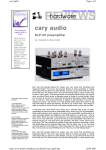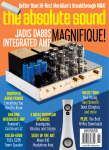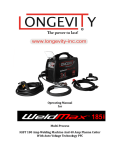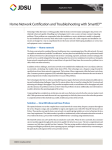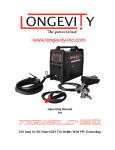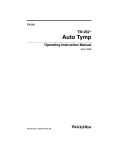Download Soulution 500 Series Electronics
Transcript
go to: Contents | Features | Integrated Amps | Power Amps | Power Amps/Preamps Pairs | Preamps, Phonostages, Receivers | Headphone Amps | Editors' Choice T he $26,000 Soulution 520 full-function preamplifier and $55,000-per-pair 501 monoblock amplifiers are terrific. Sweet in timbre, incredibly fast, and sensationally detailed from top to bottom, they match (or very nearly) the superlative Technical Brain EX and Constellation Performance gear in speed and resolution, although you might not guess this at first because (like their bigger, more expensive brothers, the Soulution 700 Series components) the 500s don’t have the laser-like focus of Technical Brain or Constellation. They are “bigger”-sounding than these others, and because they image slightly more diffusely (the difference is almost exactly like the difference between the imaging of a really good planar loudspeaker and a really good dynamic one) you may at first think they are going to be “politer,” more laid-back, and less detailed than the competition. I say “at first” because as soon as a hard transient comes along—like those startlingly realistic violin (and piano) pizzicatos in the second movement of George Crumb’s Four Nocturnes [Mainstream/ Time] or the near-string-busting snap of Keb’ Mo’s National guitar on “Every Morning” from his eponymous first album [MoFi] or the tremendous bass drum thwack at the start of Poulenc’s delightful Concerto for Two Pianos [Decca]—you’ll know without question that “polite” and wanting in immediacy and detail are the last things that Soulution’s new electronics are. You’ll also know without question— particularly from the Concerto for Two Pianos—that these 500 Series components have some of the most lifelike bass you’ve ever heard from mere stereo gear. Soulution 500 Series Electronics Phenomenal Jonathan Valin 92 Guide to High-End Electronics previous page Generally I don’t get all worked up about the bottom octaves of speakers or electronics. Sure it’s swell to have “floor” and “jump” and “slam” and all those good things that you hear in an actual concert hall. The trouble is that it’s hard to get those good things in an average listening room without getting a whole bunch of bad ones along with them (like a huge midbass hump at room or port resonance, or a steep roll-off in the low bass, and/or a pronounced suckout in the power range). Getting deep, powerful midbass that also sounds “continuous” (to use Harry Pearson’s great, multipurpose word) with the octaves above and below it is a neat trick, and very few loudspeakers can bring it off without a few tricks of their own. Take my current reference speaker, the Raidho C 4.1 (reviewed elsewhere in this issue). This sevendriver, ribbon/ceramic-cone hybrid, D’Appolito floorstander uses four 160mm ceramic-sandwich woofers, mounted, as are all of the C 4.1’s drivers including the central ribbon, on thick anodized aluminum plates bolted to a tall, slender, taperedin-the-back, dual-ported-in-the-front reinforcedMDF enclosure. The load this large multiway presents to an amp isn’t particularly difficult (a nominal 5.8-ohm impedance with a sensitivity in the upper 80s); nonetheless, meeting the conflicting demands of such a hybrid critter isn’t all that easy for any amp to do. To come to fullest life the C 4.1 requires an amplifier that is capable of unusual power and grip in the bass and, at the same time, very low distortion, high speed, and exceptional delicacy in the upper midrange and treble (where that ribbon driver plays). Generally speaking, most amps are going to be better at one task than at the other. For instance, www.theabsolutesound.com NEXT page go to: Contents | Features | Integrated Amps | Power Amps | Power Amps/Preamps Pairs | Preamps, Phonostages, Receivers | Headphone Amps | Editors' Choice EQUIPMENT review - Soulution 500 Series Electronics both the Technical Brain and Constellation amps are speed demons, with lightning transient response, tremendous resolution of inner detail, and (given the right source) gorgeous (and highly realistic) midband-to-treble tone color and texture. However, as it turned out, with the C 4.1 neither of them was supplying the grip and impact in the bottom octaves that the Soulution 501/520 supplies. While the Soulution 500 Series electronics didn’t exactly turn the C 4.1 into a thump-in-the-chest machine, they certainly increased its low-end “wow” factor to sensational levels. With the Soulution 501/520, the midbass and upper bass (from about 45Hz to 125Hz) 93 Guide to High-End Electronics previous page immediately sounded more prominent and powerful, as if the 501s had seemingly elevated those frequencies by a few dB (although they have not). Suddenly the C 4.1 had floor, jump, slam. And yet the additional mid-to-upper bass energy wasn’t overshadowing the very low bass or cheating me of color, power, and heft in the 100Hz to 400Hz power range. Indeed, via the 501s the C 4.1’s output between 30 and 40Hz was measurably the same as its output at 1kHz, and so was its output in the power range. Now the greater prominence of mid-to-upper bass in the Raidho C 4.1 may constitute a bit of a departure from strict neutrality, but it certainly makes for a very concert-hall-like low end when the amplifier driving the Raidho is capable of supplying enough voltage at a fast enough slew rate and with enough of a damping factor to wring more information about pitch, color, intensity, and duration out of the bottom octaves. The Soulution 501 monoblock and 520 preamplifier do this very thing—spectacularly well. The word “solid” best describes the Soulution low end—solid not just in a three-dimensional sense (although it is that), but also in a continuous, “of-a-single-piece” sense. Like a chunk of black marble, the mid-to-upper bass seems to have been expertly chiseled to make a perfectly seamless fit with the power range above it and the deep bass below. Getting this kind of weight and sheer exhilarating impact along with superb pitch definition and astonishing resolution of timbre and texture in both the bottom-most octaves and the power range isn’t usually in the cards outside of a concert hall, where you hear it all the time on orchestral tuttis or instrumental fortissimos. One of the secrets to both the 500 Series’ and the 700 Series’ sonic success is standard-settingly lower distortion, achieved by slightly unusual means. Where every other tube and solid-state amp designer I can think of flees from negative feedback like the plague, Soulution has rushed to embrace it. It is Soulution’s contention that negative feedback in itself has gotten a bad rap; it isn’t feedback but the time it takes to send the “corrected” signal from the output to the input (technically, propagation delay) that causes the problems. Unless that propagation delay is zero or close to zero, applying feedback will add time-domain errors to the musical signal, since music doesn’t sit still for a glamour shot and as time goes by the feedback loop will be “comparing apples at the output to oranges at the input” (in the words of Cyrill Hammer, Soulution’s CEO—for more of whose wisdom, see the interview accompanying this review). In the 700 Series, Soulution’s, uh, solution to the propagation delay problem was to increase the amp’s bandwidth to the megahertz region and, thereby, increase the speed with which the feedback loop does its thing by a factor of 1000. Most amplifiers and preamplifiers work with a propagation delay of 1–5 microseconds; Soulution’s amplifiers and preamplifiers work with an overall propagation delay of 5–10 nanoseconds, reduced to 1–2 nanoseconds in the voltage www.theabsolutesound.com NEXT page go to: Contents | Features | Integrated Amps | Power Amps | Power Amps/Preamps Pairs | Preamps, Phonostages, Receivers | Headphone Amps | Editors' Choice EQUIPMENT review - Soulution 500 Series Electronics amplification stage—where most of the negative feedback is applied. To quote Hammer again: “Since the timing errors of the Soulution amplifiers are negligible, we have the opportunity to apply as much negative feedback as we need wherever it is required in the amplifier without reducing sonic performance. This is how we can lower distortion to never-beforeseen levels.” Lower distortion certainly helps explain the Soulution 501/520’s terrific top-tobottom clarity and resolution. But the phenomenal distortion numbers alone (THD is less than 0.001% and SNR greater than 120dB) can’t explain why Soulution’s new 500 Series electronics sound so world-beatingly “real” (and exciting) in the bottom octaves and the power range. You might think that its power delivery was a matter of sheer watts, but, while more than capable of driving the C 4.1s to runfrom-the-room levels, the 501s are only rated at 125W into 8 ohms, 250W into 4 ohms, and 500W into 2 ohms. Voltage, amperage, and peak power, however, are different stories. At a glance, you would never think it— the 501s are actually quite compact, about a quarter the size of the humongous 700s and purely Bauhaus utilitarian in the looks department—but these little Soulutions put out 70V RMS, 45A, and 5000W of impulse power at a slew rate of 900ns with a damping factor that exceeds 10,000! The sheer, seemingly inexhaustible flow of power from these small, plain-looking 94 Guide to High-End Electronics previous page things (fed by the every-bit-as-outstanding 520 preamplifier) unquestionably has something to do with “improvements” that Soulution has made to the power supplies. Unlike the original 700 Series amplifiers, the 500 Series uses “switch-mode” supplies—two of them, electrically isolated from each other (and from the audio circuit) by opto-couplers and transformers, “high-performance-filtered” for noise at the inputs and outputs, and high-speed voltage-regulated. Each of these switchmode supplies is capable of delivering 600VA, and Soulution claims that, together, they “deliver considerably more stable power than any conventional, transformerbased technology.” (Lest you be confused, the Soulution 501 is not a Class D amp. Though it uses a switch-mode power supply, its gain stages run in Class AB, heavily biased toward Class A. In addition to the switch-mode supplies, the 501 also uses four linear power supplies for other functions.) The upside of switch-mode supplies as I understand it (make that “as Robert Harley explained it to me”) is that they keep the power supply constantly and fully charged no matter what the signaldemands; they can also be power-factorcorrected (so that wattage and voltage are not slightly out of phase, as they are in conventional supplies). I know there are switch-mode naysayers, who point out that, even if filtered and shielded, the strong noise (chiefly RF) of the digital switching signal Operating the 500 Series Electronics There really isn’t a lot you need to know about setting up and the LED screen, pressing the dial in again once you’ve using Soulution’s new 501 amplifier. Outside of an EIC power- made your selection (the three LEDs go off), and pressing cord inlet, a power-on switch, and XLR connector (no RCA) the Program button again to return to operating mode. It for the input from your preamp, an XLR output connector may sound complicated but it becomes second nature once (for God knows what), and what Soulution calls its “Link” you’ve done it a couple of times; moreover, it can also be connector (for slaving the amps and preamps to the remote done via the remote. control) on the back panel, there really isn’t much to the 501. On the rear panel of the preamp are an EIC power-cord On the front panel is a single rotary dial that switches (with a inlet, a power-on switch, four sets of line-level inputs (two click) among three positions—off, standby, and on. To operate XLR-only and two RCA-only), a single set of RCA inputs for the amplifier you simply turn the dial to the “on” position. the phonostage (with two banks of DIP switches between You can leave the amp in standby or off when not using it, them for independently setting the loading of the left and although I will have a proviso about this later on. right channels), two sets of preamp outputs (one XLR The 501 preamp is quite a bit more complex. Like the 501, and one RCA, the latter of which is odd since there is no it has a multi-function rotary control on its front panel, which RCA input on the 501 amplifier), and those Soulution Link can be used to adjust the volume by rotating it, to lower the connectors. volume of the preamp to a pre-set minimum by pressing it There was and is an operational quirk on my very early pair in (you press it in again to return to the volume set prior of 501s. One of the amps would and will occasionally trigger to muting), and to program the preamp in certain ways. (All its protection circuit on turn-on, which then requires me (as of these functions are duplicated on the handy remote.) To with a modem) to unplug it from the wall, let it sit for a time, the left of the rotary control are three buttons: Power, Prog and then re-plug it in. Apparently with these first 501s, the (for “Program”), and Mute. And to the left of the buttons is turn-on sequence of the power supplies is being “misread” a rectangular LED display, the intensity of which can (and by the amp’s protection circuit, which sees a problem should) be dimmed during playback. where there is none. I am told that this programming issue The operating parameters of the preamp can be adjusted was identified and corrected in later-build samples of the in many different ways by pressing the “Prog” button (which 501 (mine are from the first batch, better than a year old). puts the preamp in “Program mode”). In this mode, you can Nonetheless, I am noting the problem, which is annoying, out adjust balance, volume limits, phonostage subsonic filtering, of due diligence. display dimming, etc. by selecting the parameter you want Let me also note that as much as I like the 520’s built-in to change via the rotary dial, which cycles through a list on phonostage (and I love it), I wish that Soulution had included the LED readout, pressing the dial in to engage program a second set of inputs (à la ARC and others) for those of mode for that parameter (three LEDs light on the display us with more than one turntable. I also wish that cartridge when you do this), again rotating the dial to select whatever loading could be set via the Program mode rather than by change you want to make from the options displayed on DIP switch. It would be more convenient. www.theabsolutesound.com NEXT page go to: Contents | Features | Integrated Amps | Power Amps | Power Amps/Preamps Pairs | Preamps, Phonostages, Receivers | Headphone Amps | Editors' Choice EQUIPMENT review - Soulution 500 Series Electronics can be radiated throughout the circuit. All I can tell you is that I don’t hear this issue. What I am hearing is that when an amp has no droop or phase shift in the supply at any level with any signal, the net effect seems to be equivalent to plugging your speakers directly into a wall socket. When it comes to dynamic linearity the 501 is simply nonpareil (although I have a feeling that its big brother, the newly redesigned 701, now also equipped with a switch-mode power supply, may be nonpareiler). Here’s the thing: Every other amp I’ve listened to, tube or solid-state, reaches a point where it simply can’t get louder or more dynamic without also audibly changing its sonic character. Sometimes, this pivot point comes relatively early on, as it did with the puny ARC Reference 210 monoblocks (less so with the stouter Reference 250s); sometimes it comes relatively late, as it did with the Constellation Centaur. But come it does. And when it comes, the music doesn’t just get louder (if it does get louder); it also gets more distorted. Typically, timbres begin to lose their natural sweetness, becoming thinner, more skeletal; with the loss of tone color textural details seem to be planed away, too, so that the resolution of instrumental body and performer articulations is reduced; transients and big dynamic swings often acquire a sharp, unpleasant edge or, alternately, sound flattened out, as if they’re being compressed against an invisible loudness ceiling; the soundstage, in turn, congeals, as if it, too, is being pressed against a pane of glass; 95 Guide to High-End Electronics previous page what was orderly and beautiful becomes disorderly and clamorous; what was realistic becomes unmistakably the sound of a recording poorly reproduced. Understand that all of these effects set in well before actual clipping. Understand, as well, that this sense of strain is one of the foremost differences between music performed live and music played back on a stereo. Up until it can give no more and its protection circuits simply shut it down to silence, the 501 is the only amp I’ve heard that doesn’t do any of this. It just keeps getting louder without any change in sonic character—at SPLs so far beyond what you might expect from its nominal 125 watts that its actual output is difficult to gauge. And because it keeps getting louder without strain or outright distortion magical things happen in the bass and power range on big dynamic moments. Tymps, bass drums, gongs, doublebasses, trombones, sarrusophones, tubas, trumpets, bassoons and contrabassoons, bass clarinets, saxophones, pianos, organs acquire the acoustical power that they have in life on big orchestral tuttis—that sense of effortless, seemingly limitless power focused by the hall and projected toward you with enough physical force to be felt like an onrushing wave—and to thrill you with its impact. With the 501s, bass-range instruments gain sweetness, texture, solidity, and energy as they get louder, as if the amps were continuously kicking themselves into higher gears—as if there were no end to the gears they could engage. SPECS & PRICING Soulution 501 Monoblock Amplifier Weight: ?? lbs. Inputs: One analog XLR Price: $26,000 Outputs: One analog XLR, one pair of binding posts Power: 125W@8 ohms, 250W@4 ohms, 500W@2 ohms JV’s Reference System Output voltage max.: 70V RMS Loudspeakers: Raidho C 4.1, Raidho C1.1, Raidho D1, Estelon Output current max: 45A X Diamond, MartinLogan CLX, Magnepan 1.7, Magnepan 3.7, Impulse rating: ~5000W Magnepan 20.7 Sensitivity: 1.55V RMS Linestage preamps: Soulution 520, Constellation Virgo, Audio Voltage amplification: +26dB Research Reference 10, Siltech SAGA System C1 Frequency response: DC–800kHz Phonostage preamps: Audio Research Corporation Reference Slew rate: 900ns Phono 2SE, Innovative Cohesion Engineer-ing Raptor, Distortion (THD+N): <0.001% Soulution 520 Signal-to-noise ratio: >120dB Power amplifiers: Soulution 501, Constellation Centaur, Audio Damping factor: >10,000 Research Reference 250, Lamm ML2.2 Input impedance: 2k ohms Analog source: DaVinci AAS Gabriel Mk II turntable with Output impedance: 0.001 ohms DaVinci Master’s Reference Virtu tonearm, Walker Audio Dimensions: 442 x 143 x 448mm Proscenium Black Diamond Mk V record player, AMG Viella 12 Weight: ?? lbs. Phono cartridges: Clearaudio Goldfinger Statement, Ortofon Price: $55,000/pr. MC A90, Ortofon MC Anna, Benz LP S-MR Digital source: Berkeley Alpha DAC 2 Soulution 520 Preamplifier Cable and interconnect: Synergistic Research Galileo, Crystal Inputs: Two balanced XLR, two unbalanced RCA, one phono Cable Absolute Dream (five total) Power Cords: Synergistic Re-search Tesla, Shunyata King Outputs: One balanced XLR, one unbalanced RCA Cobra, Crystal Cable Absolute Dream Impedance: Balanced (Inputs 1 and 2), 3k ohms; unbalanced Power Conditioner: Synergistics Research Galileo, Technical (Inputs 3 and 4), 3k ohms; phono (Input 5), adjustable Brain Output gain: Balanced, +16dB; unbalanced, +10dB Accessories: Synergistic ART system, Shakti Hallographs Frequency response: DC–800kHz (6), A/V Room Services Metu panels and traps, ASC Tube THD+N: <0.001% Traps, Critical Mass MAXXUM equipment and amp stands, Signal-to-noise ratio: >120dB Symposium Isis and Ultra equipment platforms, Walker Valid Crosstalk: <120dB Points and Resonance Control discs, Clearaudio Double Matrix Impedance: Balanced, 10 ohms; unbalanced, 10 ohms SE record cleaner, HiFi-Tuning silver/gold fuses Dimensions: 442 x 143 x 448mm CLICK HERE TO COMMENT at www.theabsolutesound.com www.theabsolutesound.com NEXT page go to: Contents | Features | Integrated Amps | Power Amps | Power Amps/Preamps Pairs | Preamps, Phonostages, Receivers | Headphone Amps | Editors' Choice EQUIPMENT review - Soulution 500 Series Electronics There is no question in my mind that it is the combination of exceedingly low distortion, astounding speed, almost limitless voltage, amperage, and peak power, and tremendous damping that allows the Soulution 501s to bring a speaker like the Raidho C 4.1s to such incredible life in the bottom octaves and the power range where grip, damping, transient response, and unlimited power are all-important. But what about the midrange and the treble octaves? What about the delicacy, speed, and sweetness they require? If you’re expecting that other shoe to drop here, you’re going to be disappointed. True, their bass/ power-range color, definition, and dynamics may be their most salient features simply because in the bass and on big dynamic swings—such as the Catherine Wheel fireworks of the Feria that closes Ravel’s Rapsodie espagnole on Acoustic Sound’s marvelous reissue of The Reiner Sound or the avalanche power of the Basie band’s brass section on “Street of Dreams” from Sinatra Live at the Sands [MoFi] or the deep-reaching ostinatos of Paul’s Gretsch bass guitar and the slug-to-themidsection accents of Ringo’s tom on the 15ips Puget Sound dub of Sgt. Pepper—they sound so unlike other electronics sound when pushed past their comfort zone. That said, the 501 and 520 are almost as good at soft and thrilling as they are at loud and thrilling. I’ve mentioned Keb’ Mo’s National guitar on his eponymous debut album, which the Soulution amp and preamp don’t just reproduce with snap and speed, but with a thrillingly lifelike density of color and texture on overtones that is new to Soulution electronics—and quite beautiful to hear. The 500 Series gear is just as good on Keb’ 96 Guide to High-End Electronics previous page Mo’s head-cold of a voice, which (given the right speaker and the right room) it reproduces with jaw-dropping realism, making the Raidho C 4.1s sound very much like a ’stat, which is to say at one and the same time naturally hued, in-the-room present, and see-through transparent (though unlike a ’stat the C 4.1 doesn’t flatten aspect and lose three-dimensional body). On high-pitched instruments (or instruments with strong treble-range overtones), the Soulution 501/520 is just as discerning as it is in the bass and midrange, reproducing upper-octave piano with its ivory-and-felt colors—and the weight of the performer’s touch—fully intact. Ditto on cymbals, bells, flutes, piccolos. The Soulution gear not only reproduces these things with natural sweetness; it reproduces the engineering— always a strong point of the ultra-high-resolution Soulution electronics—with utter clarity. As a result, the strings, winds, and percussion on the great, albeit slightly dry Columbia [EMI] recording of Von Karajan’s thrilling performance of Bartok’s Music for Strings, Percussion, and Celesta sound (as they should) slightly dry, where on a richly colored, highly ambient recording like the aforementioned Reiner Sound, strings, winds, and percussion have the dark, silken beauty they’re supposed to have. Having said this, I would have to admit that the Soulution 500 Series tends to be a little soft, sweet, and recessed on the very top, perhaps because it is so very strong on the bottom. All that weight and energy in the bass and power range tends to give it a slightly more bottomup (to use Michael Børresen’s phrase) kind of presentation, where the Technical Brain and Constellation gear sound more top-down. I would also have to say that in spite of its incredible lowlevel resolution I’ve heard a couple of amps that marginally exceed it in this regard—the original Soulution 710, for example, when paired with the ultra-high-resolution MartinLogan CLXes or the original Technical Brain TB-Zero v2 electronics with Apogee speakers, which produced a wealth of inner detail such as I’ve never heard before (or again) from solid-state electronics. However, the added resolution of both of these ultra-high-resolution products came at a clear and objectionable cost in density of tone color; they were both lean in timbre. The Soulution 500 Series is more natural sounding than both, and the difference between it and TB or Soulution’s own earlier amps and preamps in resolution is, honestly, miniscule. Plus, both of these other amps and preamps cost twice the dough of the 500 Series gear. As for ambience and sountstaging, though the 520—which comes equipped with a marvelous phonostage, with loading that is adjustable via DIP switches on the rear panel and an RIAA IEC subsonic filter that is actually quite effective and relatively inaudible (oh, you do lose a little “floor” on certain power-discs that can be recaptured by simply turning the subsonic filter off)—doesn’t reproduce ambience on, say, the richly resonant 45rpm Acousence recording of the Belenus Quartet playing Bartók’s Fourth Quartet with quite the same cavernous width and depth as the superb stand-alone Audio Research Reference Phono 2 phonostage paired with ARC’s superb new, two-box, $30k Reference 10 linestage, it comes closer than most of the other solidstate competition I’ve heard (plus it is marginally faster than the ARC combo and, in all respects, considerably better in the bass than the ARC—or anything else). Though they aren’t the only goodies in Santa’s bag, in the sector of the market in which they compete the new Soulution 500 Series (which also includes the 540 CD/SACD/DAC) are unquestionably must-audition products, but then if you’ve heard them in Munich and elsewhere driving Focal Stella Utopias to previously undreamed-of heights you already know that. Naturally, they come with my highest, warmest, most enthusiastic recommendation. Indeed, until better comes along (from Constellation, Technical Brain, or Soulution itself), the 500 Series are my new solid-state references. www.theabsolutesound.com NEXT page





